Down-regulation of AR splice variants through XPO1 suppression contributes to the inhibition of prostate cancer progression
- PMID: 30450161
- PMCID: PMC6219671
- DOI: 10.18632/oncotarget.26239
Down-regulation of AR splice variants through XPO1 suppression contributes to the inhibition of prostate cancer progression
Abstract
Emerging studies have shown that the expression of AR splice variants (ARv) lacking ligand-binding domain is associated with castrate-resistant prostate cancer (CRPC) and higher risk of tumor metastasis and recurrence. Nuclear export protein XPO1 regulates the nuclear localization of many proteins including tumor suppressor proteins. Increased XPO1 in prostate cancer is associated with a high Gleason score and bone metastasis. In this study, we found that high expression of AR splice variant 7 (AR-v7) was correlated with increased XPO1 expression. Silencing of XPO1 by RNAi or treatment with Selective Inhibitor of Nuclear Export (SINE) compounds selinexor and eltanexor (KPT-8602) down-regulated the expression of AR, AR-v7 and ARv567es at mRNA and protein levels. XPO1 silencing also inhibited the expression of AR and ARv regulators including FOXA1, Src, Vav3, MED1 and Sam68, leading to the suppression of ARv and AR target genes, UBE2C and PSA. By targeting XPO1/ARv signaling, SINE suppressed prostate cancer (PCa) growth in vitro and in vivo and potentiated the anti-cancer activity of anti-AR agents, enzalutamide and abiraterone. Therefore, XPO1 inhibition could be a novel promising agent used in combination with conventional chemotherapeutics and AR-targeted therapy for the better treatment of PCa, especially CRPC.
Keywords: AR SPLICE variant; CRM1; SINE; metastatic prostate cancer; nuclear export.
Conflict of interest statement
CONFLICTS OF INTEREST William Senapedis, Erkan Baloglu, Yosef Landesman, Michael Kauffman, Christian Argueta, Trinayan Kashyap, Hua Chang and Sharon Shacham are employees of Karyopharm Therapeutics and hold patents, equity and stocks and have received both major and minor remunerations from Karyopharm. All other authors have no potential conflict of interests.
Figures
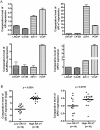
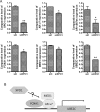
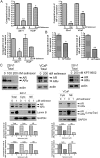
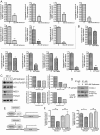

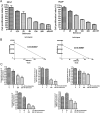
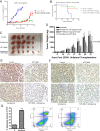
Comment in
-
Selective inhibitors of nuclear export: potential therapeutics for AR variant-expressing prostate cancer.Oncotarget. 2018 Nov 9;9(88):35797-35798. doi: 10.18632/oncotarget.26296. eCollection 2018 Nov 9. Oncotarget. 2018. PMID: 30533190 Free PMC article. No abstract available.
Similar articles
-
Targeting Nuclear Exporter Protein XPO1/CRM1 in Gastric Cancer.Int J Mol Sci. 2019 Sep 28;20(19):4826. doi: 10.3390/ijms20194826. Int J Mol Sci. 2019. PMID: 31569391 Free PMC article.
-
Transcript Levels of Androgen Receptor Variant 7 and Ubiquitin-Conjugating Enzyme 2C in Hormone Sensitive Prostate Cancer and Castration-Resistant Prostate Cancer.Prostate. 2017 Jan;77(1):60-71. doi: 10.1002/pros.23248. Epub 2016 Aug 22. Prostate. 2017. PMID: 27550197
-
Nuclear Export Inhibitor KPT-8602 Synergizes with PARP Inhibitors in Escalating Apoptosis in Castration Resistant Cancer Cells.Int J Mol Sci. 2021 Jun 22;22(13):6676. doi: 10.3390/ijms22136676. Int J Mol Sci. 2021. PMID: 34206543 Free PMC article.
-
Androgen receptors in hormone-dependent and castration-resistant prostate cancer.Pharmacol Ther. 2013 Dec;140(3):223-38. doi: 10.1016/j.pharmthera.2013.07.003. Epub 2013 Jul 13. Pharmacol Ther. 2013. PMID: 23859952 Review.
-
The past, present, and future of CRM1/XPO1 inhibitors.Stem Cell Investig. 2019 Feb 25;6:6. doi: 10.21037/sci.2019.02.03. eCollection 2019. Stem Cell Investig. 2019. PMID: 30976603 Free PMC article. Review.
Cited by
-
New drugs are not enough‑drug repositioning in oncology: An update.Int J Oncol. 2020 Mar;56(3):651-684. doi: 10.3892/ijo.2020.4966. Epub 2020 Jan 20. Int J Oncol. 2020. PMID: 32124955 Free PMC article. Review.
-
The Crucial Role of AR-V7 in Enzalutamide-Resistance of Castration-Resistant Prostate Cancer.Cancers (Basel). 2022 Oct 5;14(19):4877. doi: 10.3390/cancers14194877. Cancers (Basel). 2022. PMID: 36230800 Free PMC article. Review.
-
PAK4-NAMPT Dual Inhibition as a Novel Strategy for Therapy Resistant Pancreatic Neuroendocrine Tumors.Cancers (Basel). 2019 Nov 29;11(12):1902. doi: 10.3390/cancers11121902. Cancers (Basel). 2019. PMID: 31795447 Free PMC article.
-
Selective inhibitors of nuclear export: potential therapeutics for AR variant-expressing prostate cancer.Oncotarget. 2018 Nov 9;9(88):35797-35798. doi: 10.18632/oncotarget.26296. eCollection 2018 Nov 9. Oncotarget. 2018. PMID: 30533190 Free PMC article. No abstract available.
-
FOXA1 in prostate cancer.Asian J Androl. 2023 May-Jun;25(3):287-295. doi: 10.4103/aja202259. Asian J Androl. 2023. PMID: 36018068 Free PMC article. Review.
References
-
- Siegel RL, Miller KD, Jemal A. Cancer Statistics, 2017. CA Cancer J Clin. 2017;67:7–30. - PubMed
-
- Donovan MJ, Osman I, Khan FM, Vengrenyuk Y, Capodieci P, Koscuiszka M, Anand A, Cordon-Cardo C, Costa J, Scher HI. Androgen receptor expression is associated with prostate cancer-specific survival in castrate patients with metastatic disease. BJU Int. 2010;105:462–67. - PubMed
-
- Sircar K, Yoshimoto M, Monzon FA, Koumakpayi IH, Katz RL, Khanna A, Alvarez K, Chen G, Darnel AD, Aprikian AG, Saad F, Bismar TA, Squire JA. PTEN genomic deletion is associated with p-Akt and AR signalling in poorer outcome, hormone refractory prostate cancer. J Pathol. 2009;218:505–13. - PubMed
-
- de la Taille A, Rubin MA, Chen MW, Vacherot F, de Medina SG, Burchardt M, Buttyan R, Chopin D. Beta-catenin-related anomalies in apoptosis-resistant and hormone-refractory prostate cancer cells. Clin Cancer Res. 2003;9:1801–07. - PubMed
-
- Azoulay S, Terry S, Chimingqi M, Sirab N, Faucon H, Gil Diez de Medina S, Moutereau S, Maillé P, Soyeux P, Abbou C, Salomon L, Vacherot F, de La Taille A, et al. Comparative expression of Hedgehog ligands at different stages of prostate carcinoma progression. J Pathol. 2008;216:460–70. - PubMed
Grants and funding
LinkOut - more resources
Full Text Sources
Other Literature Sources
Research Materials
Miscellaneous

